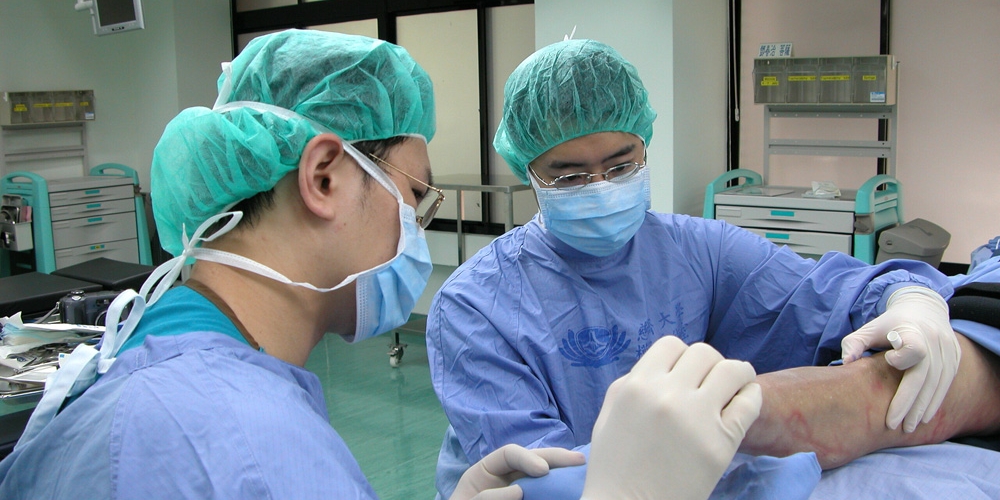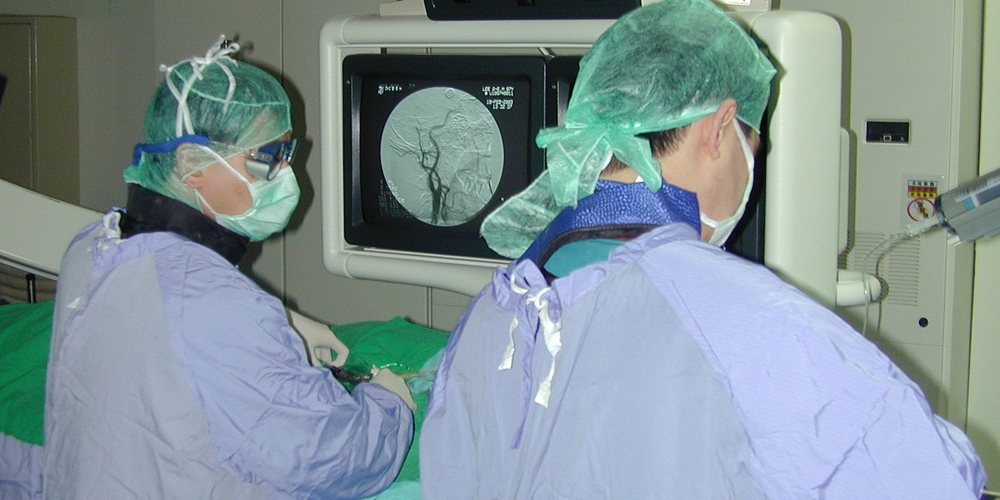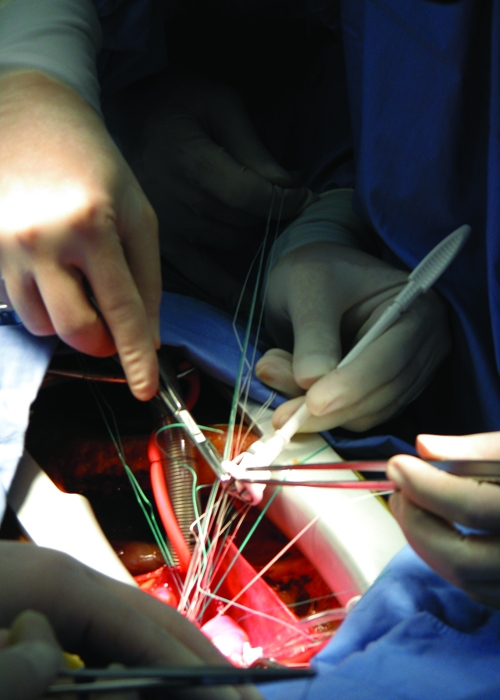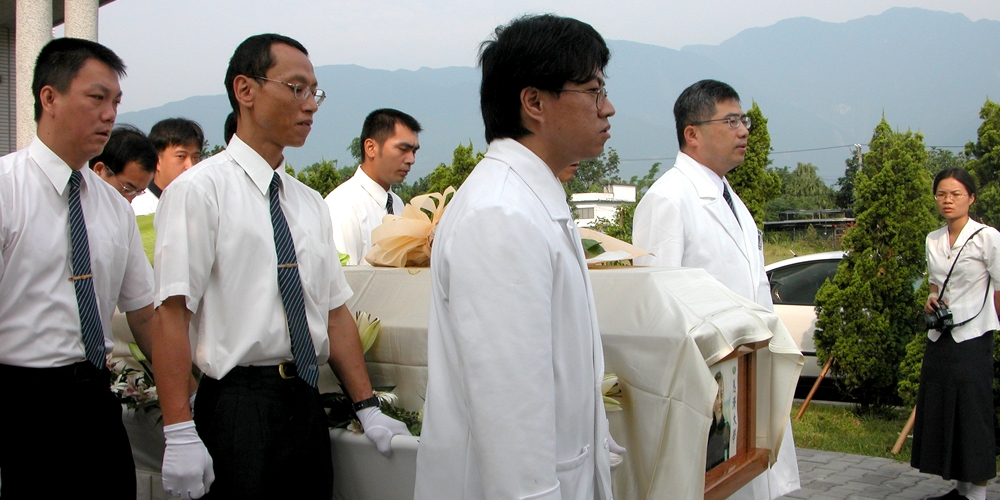Trainings for Medical Students and Doctors
Translated by Margaret Hsiao
The anatomy class, is a crucial milestone for every medical student in his or her medical career in pursuit of understanding and curing the human body.
Tzu Chi Medical Education has modifi ed its courses to honor the wishes of the “Silent Mentors,” or those who have donated their bodies for the purpose of medical education. The Great Body education has been extended from basic anatomy in the third year of medical school to clinical surgery training in the sixth year. The target audience has been expanded from resident physicians to surgical assistants to give students and doctors a valuable learning opportunity. The goal is to train the students and even senior doctors to provide the best medical cures for the patients.
The deceased bodies are donated to further doctors’ and nurses’ practice in order to help other people. The Silent Mentors, whose decisions are filled with love and wisdom, enable other lives to continue. This is the very essence of humanity’s eternal capacity to give.
Inquisitiveness is part of human nature. It is as if people intrinsically possess the curiosity to see how the world works, dissecting objects that intrigue them, such as watches, toys, or electronic devices.
Endless Curiosity Initiated Medicine Knowledge
In Greek mythology, Pandora opened a box out of curiosity and let out all the evils that have since afflicted humankind. In man ’s life from birth to death, self awareness gradually awakens, and curiosity leads to questions, and answers and solutions are sought. This ancient process has led to the accumulation of knowledge in a variety of fields, including medicine.
Aristotle believed that philosophy stemmed from curiosity. For him, curiosity was equivalent to knowledge and wisdom. Kant said that curiosity was the ultimate manifestation of human reasoning. It motivated people to understand themselves and to objectively perceive the essence of this world.
The unavoidable events of life -- birth, aging, illness and death -- caused impairment of human bodies since man first walked the earth. People became inquisitive about their own body structures in the hopes of finding cures for diseases.
However, ancient religions shunned death and taught people to become afraid of cadavers, believing that close contact would invite evil spirits. Also, because of public health reasons, the deceased were buried immediately and dissection was forbidden to avoid transmission of plague. In the Chinese Yin-Shang era, there was no written character that signified “medicine.” Instead the “ ” character implied that medicine was mixed with witchcraft in ancient times.
In the 6th century B.C., Greek philosophy underwent a major movement and liberated medicine from superstition. Diseases were no longer the acts of evil sprits, but the results of natural factors. Because of religious and cultural prohibitions, human anatomy was mainly learned from animals, remnant human body parts, and disabled soldiers. Hippocrates was the symbolic figure of this time. He introduced the field of medicine as a form of art. Because of his efforts of reaffirming the duties of physicians and maintaining the dignity of medicine, he was bestowed the title – “Father of Western Medicine.”
Systematic Approach to Understand Diseases
In 162 A.D., Claudios Galen continued Hippocratic tradition. Based on basic scientific knowledge of anatomy and biology, he established a systematic approach to understand the pathophysiology of different diseases. His theories were regarded as the golden standards of medicine for the next one thousand years. However, the majority of his knowledge of anatomy was based on animals and not humans, so there were mistakes. It was not until the 16th century when an Italian, Andreas Vesalius (1514~1564), used human anatomy as his foundation for establishing medical principles, that many errors of his predecessors were corrected and modern human anatomy was founded.
In the East, knowledge about human anatomy was already well established by the Han Dynasty. In the Book of Shi, detailed dissection techniques were meticulously documented. In the famous medical literature, “Emperor Huang’s Manuscript, ” human anatomy was properly recorded. It provided specific details on the length, weight, and volume of human bones, organs, and vasculature.
Back in Europe, during the Renaissance period, studying human anatomy had become a popular field. King Henry VIII of England ordered the bodies of executed prisoners to be dissected. This “double punishment ” was thought to prevent the souls of the prisoners from ascending to heaven. The story of Frankenstein (1818) portrayed the prevalence of stealing cadavers for dissection and exemplified the rapid progress in human dissection procedures. Private anatomy dissection institutes prevailed in the 18th and 19th century in England. The large demand for human cadavers resulted in illegal transactions. Furthermore, cadavers were not treated in a respectful manner.
In the past whether in the East or the West, it was very rare for anyone to volunteer to be a subject for dissection. If it weren’t for these unsung heroes, medicine would not have reached today’s level of sophistication. Anyone who has been ill or has undergone surgeries should thank these Great Teachers. Therefore, many medical schools in the U.S, such as Stanford, New York University (NYU), Yale, University of California San Francisco, have started to reevaluate the process of taking care of donated bodies in a humane and dignified fashion.
Respect Cadavers and Be Grateful to Those Devoting Themselves to Medicine
“Great Body Donation” is a new term that has been created within the last ten years. Master Cheng Yen started advocating Great Body Donation in 1995. She said, “Life is unpredictable. Life turns from helpless to useless, and we should make good of it and add value to the meaning of life.” Many people agree with the idea and consent to donate their bodies to medical schools for studies after they pass away.
Studying human anatomy is the beginning of medicine. After going through dissection courses students will enhance their understanding of the human body and ofthe mission of physicians.
It had been reported that during anatomy classes, sometimes medical students would throw the donor’s heart around jokingly. Tzu Chi University Dissection Director Chen Hong-bin recalled that even as of ten years ago, medical students had to immerse themselves in icy cold freezers filled with fumes of formaldehyde to pack the bodies into bags to carry on their shoulders to classes. These actions showed great disrespect for the bodies.
“Master says, when you become a doctor, doctors are Medical Bodhisattvas. I will give you my body to experiment; you can make as many mistakes on me, but never make a mistake on the patient. ” These were the words of Great Body donor Li He-zhen to a group of medical students. These words should be deeply embedded in all medicine students’ hearts. Medical students and nurses call these Great Body donors “Silent Mentors ”; they pay their respects before and after each class.
Veteran Doctors Demand Precision in Surgery Procedure
At the end of August, a memorial service was about to begin at Tzu Chi University Reflection Hall. In the early morning before seven o’clock, 20 medical staff and 20 volunteers walked into Reflection Hall and paid respect to two “Silent Mentors. ” These Mentors had special relationship with Tzu Chi. Chang Jian Fu-jia was the birth mother of Master Shih De Nian from The Abode of Still Thoughts; Deng Chunji was a veteran Tzu Chi Commissioner with extensive experiences in international relief work.
This memorial service was to pay respect to the senior residents that were about to go through simulated surgery.
Patients fear that they will be wrongly operated upon, but don’ t doctors fear the same? Actually, doctors often dread making mistakes; they are putting their profession of a lifetime on the line. A surgeon attends school for seven years then goes into residency. In the third year of residency, the resident needs to decide on a specialty. Typically, to become a surgeon, the student needs to complete fi ve years of residency. If the student chooses plastic or neurosurgery, it takes six years of residency. Who wants to jeopardize an investment that takes a total 12 to 13 years of their youth to fulfi ll?
However, despite devoted studying of their books, the residents do not get to practice their surgical or clinical skills until they encounter their patients. The fi rst times are always intimidating for the residents, and small distractions could lead to mistakes.
This was the fi rst time Tzu Chi Hospital and University collaborated to organize a surgical course for senior residents. The purpose of the course was to foster learning for surgeons and to elevate surgery qualities and diminish medical morbidity. This allowed the fourth and fi fth year residents to perfect their surgical skills before becoming attending physicians.
The surgical routine followed the standard procedures, including pre-opassessment , documentation of the surgical process, evaluation of the procedure, and preparation for the surgery. The attending physicians served as first assistants and evaluated the procedure and provided feedback.
This simulated course was divided into six categories: general surgery, plastic surgery, neurosurgery, orthopedics, otolaryngology, and cardiothoracic surgery. Twenty-three surgical procedures were involved, including right liver excision, artificial joint replacement, and aortic valve replacement surgery. Aortic valve replacement surgery is a technically challenging procedure; the prosthetic valve alone costs several thousand dollars. This was a very valuable learning opportunity for cardiac surgeons.
Introduce Deep-Freeze Technology Bring Warmth to Simulation Scene
In order to perform a flawless simulation surgery like in a real operation room, the key was in cadaver freezing-preservation technology.
Northern Great Body Center director, Professor Zeng Guo Fan, wanted to put the increasing numbers of donated Great Bodies to good use. He got an idea when he heard that Houston Medical Center froze cadavers without treating them with preservatives for later use. Other than having no heartbeat, pulse, breath, body temperature and blood flow, the frozen cadavers were not any different from living specimens. Therefore, Tzu Chi University created simulation surgery laboratory in September 2003 to begin simulation surgery education, using these cadavers. Medical students were able to gain more confidence after the simulated surgery practice, so the course increased many students’ interest in surgery.
“Residency doctors cannot practice the difficult or novel techniques like laparoscopic surgeries on patients; they can only perform simulated procedures on machine models. It is a great learning challenge because many simulations cannot be accurately carried out with a machine. For example, the texture of the skin cannot be replicated.” Tzu Chi Hospital Vice President Shyr Ming-hwang shared his thoughts on this surgical course. “ Before they master the techniques, they do not have the opportunity to perform on patients. They have only observed as assistants and learned by watching. The opportunity of using Great Bodies as patients and having the attending physicians as assistants to supervise the process and provide feedback to the residency doctors serves as a solid learning ground. This will become part of the final exam for residency doctors to become attending surgeons.”
Simulating Difficult Procedures, Perfecting Advanced Skills
Patients will ask around to find an experienced doctor to perform an operation. If no one wants to have a novice to operate on him or her, then the new doctors will never have a chance to practice, and hence never have a chance to improve their skills.
“In the past, a surgeon would take several years to become an experienced surgeon,” says Tzu Chi Hospital Director Surgeon Lee Ming-zhe, who is also part of the simulation education planning team, as he shares his goals for the program. “To me, every patient is my teacher. No matter what, every doctor must begin with his first operation on a live patient. However, with simulation surgery, all the doctors can have a mock operation and gain the skills and experiences desired.”
He also said that all the procedures that a surgeon needs to learn can be done on the frozen Great Bodies. Any type of surgeries or any part of the body to be explored can be performed. “In the past, this was an unimaginable feat,” he said.
Cardiac surgeon Dr. Chang Bi-Song, who was a member of this course, indicated that because the surgeries are not performed on real people, it helped to relieve the stress related to surgical morbidity. Even though some necessary steps like using ice to slowly stop the heart from beating were omitted, the simulation was still a very good learning experience for the residents. They could closely study the organs and tissue structures without any time constraints. Orthopedic surgeon, Dr. Wu Wen Tang, said the course differed from programs in other countries in that it did not have similar commercial implications. Dr. Wu approves of the Great Body donation program and vows to become a Silent Mentor in the future.
Participant Dr. Lin Zeng-ming, a head and neck chief physician at Tzu Chi Hospital, praised the program because it provided intact soft tissues that were almost identical to real bodies. Another doctor, third year neurosurgery resident Dr. Tsai Sheng-tsong, commented that the same procedure would be distinct in different patients, thus every practice at the procedure was a learning opportunity.
The school and hospital’s combined efforts ultimately honor the Silent Mentor’ s hope that the number of mistakes made on patients will go down. Senior physicians also benefit from these complicated and invasive mock operations. It was with great altruism that these Silence Mentors donated their bodies in order to benefit the rest of mankind.
Utilize Cadavers to Teach Students, Salvage to Create Purpose
The simulated surgical course ended after four days. The bells chimed at Tzu Chi University on August 30. Hundreds of university medical staffs and volunteers joined together at a cremation ceremony to pay respect to these selfless Silent Mentors.
Silent Mentors may have left this world, but because they donated their cadavers for education, the cadavers were “reused” to become “useful.” They have taught the doctors to care for patients -- the fundamental intent of a savior.




